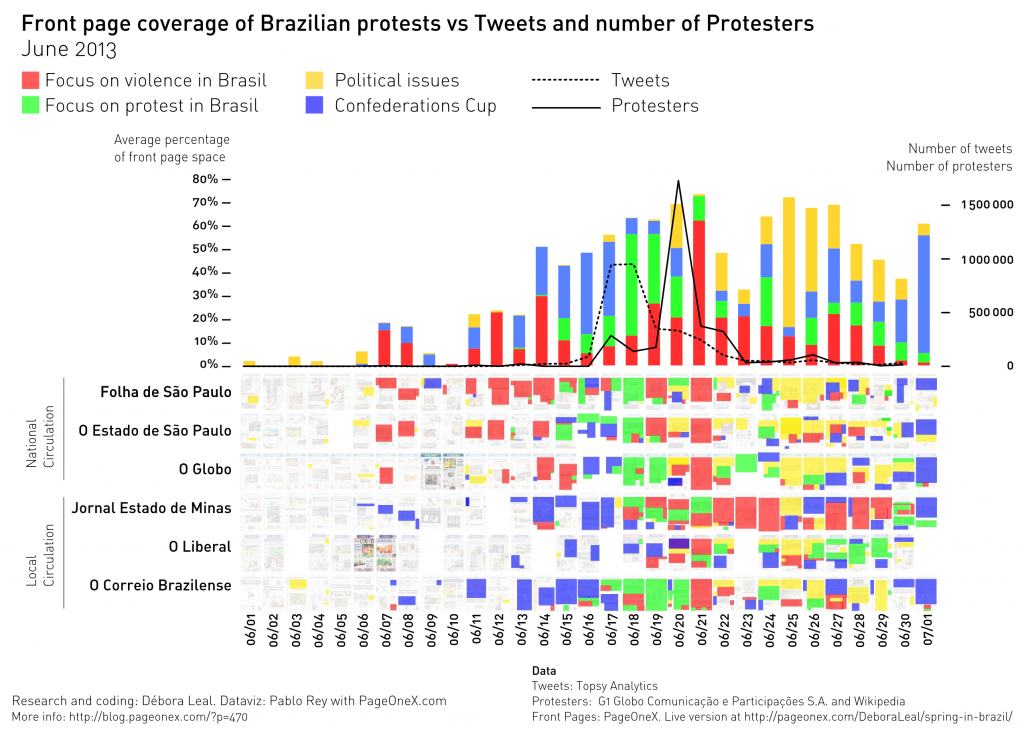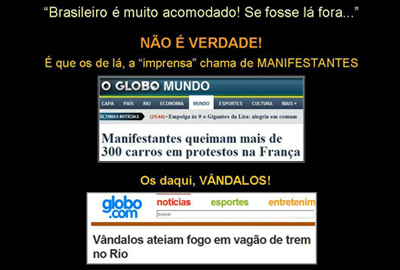
In 2012, there was an article on the internet comparing how the media approached the demonstrations in Brazil to those in France. The image shows:
- “Protesters set fire to more than 300 cars in France”
- “Vandals set fire to a train in Rio”

How is this topic addressed on the front page of traditional newspapers, in the midst of so many protests in Brazil during June? Were the newspapers calling these people protesters or vandals?
Before answering this question, it is worth reviewing what happened in Brazil that month. The 20 cent hike in the Real (less than $0.10) for the transportation fare triggered demonstrations in the main cities in Brazil. Little coverage was observed in the mainstream media. In São Paulo, demonstrations were mobilized by the Movimento Passe Livre on June 6th, 7th, 11th and 13th, with 2,000, 5,000, 10,000 and 10,000 protesters, respectively. Images and videos of the demonstrations were massively disseminated over the Internet, showing excessive police brutality against journalists, demonstrators and anyone under police target. This flood of videos and images was the catalyst for the demonstrations in other cities, and increased public support for the protests. At the end of the month there were over 600 protests. Protesters have cited more than 20 reasons to be on the streets, according to research by Brazilian statistic research institute called IBOPE. Some of these reasons were used to classified the category of the research below.
The research consisted of reading and mapping the front pages of 6 traditional newspapers;
Three newspapers with national circulation:
- O Estadão, São Paulo
- A Folha de São Paulo, São Paulo
- O Globo, Rio de Janeiro
Three newspapers with local distribution:
- Jornal Estado de Minas, Minas Gerais
- O Liberal, Para
- O Correio Braziliense, Brasilia (the capital of Brazil)
Four categories were created in order to classify the focus of each article:
- Violence (red)
- Protest (green)
- Confederation Cup – soccer tournament that acts as a rehearsal for the World Cup (blue)
- Political issues raised by the protesters (yellow)
(For a detailed description of each category, see end of text)
Based on this classification, a chart was generated showing the emphasis of the front pages (whether they were referring to the demonstrations or not) and tone (emphasizing violence or not).
The Confederations Cup was included as a category because it was happening at the same time (June 15th – 30th). The coverage referred to the tweets of the protesters on the streets the day before.
The graph reveals at least 5 interesting points:
1) Up to June 13th, the major focus of the coverage was violence (red) and the clash between protesters and police. On the 13th, several journalists were injured and arrested in São Paulo. The day after, the media seemed to make room for wider coverage (covering the reasons that motivated the protests), without focusing only on violence.
2) After the big march on June 20th, the protests dominated the newspapers’ front pages. The focus on violence was much more prevalent than the focus on the protest itself (green). By June 22nd, a significant change takes place giving us a discussion about policy reforms (yellow) rather than the protests. The president of Brazil, Dilma Rousseff, proposed a wide range of actions to begin reforming Brazil’s political system.
3) The front page focus on the protests grows in direct correlation to the citizens participation on Twitter for August 17th (hashtags used in this graph are here). After these 2 days, the tweets decrease and the focus on violence in the coverage increased.
4) The day with more protesters on the streets was not the day with more tweets about it.
5) Finally, there are two observations that are not covered in the graphic. First, the newspapers began to report about habits and vices of youth and students. Second, a relevant episode of police violence occurring after a protest was ignored by the newspapers.
Between June 18th and 24th, on the front pages of 4 newspapers, there were articles about students and teens pertaining to:
- increase in drug use,
- 76% had drunk alcohol,
- a lazy generation: no jobs or studies,
- new drug in dance club.
Analysis on previous newspapers’ covers show that there was no focus on teenagers lifestyle previous to the protests.
On June 24th, there was a protest close to a poor community in Rio de Janeiro where an unidentified group robbed protesters and people around the area of the demonstration. The police then began to look for the assailants, and by the end of the “hunt”, 1 Sergeant and 9 people were killed. All of the people killed were residents in this poor community and three had no criminal record. The next day, this story did not make any of the front pages! Just two days later, a photo related to the deaths appeared on the cover of O Estado de São Paulo. O Globo, which is the media of Rio de Janeiro, did not mention the deaths in the front page at all.
These are just some of the many points that can be analyzed from the graph above. The conclusion is that the Brazilian media have changed their emphasis on the protests, always keeping considerable space for soccer coverage.
Note: This is only the first article of a larger project of data analysis. My next step is to compare the approaches of traditional media versus the social media.
Criteria
Criteria used for the categories created:
a) Violence (red):
- Images with cars buses or objects on fire
- Pictures of police barrier, police shooting or pepper spraying
- Description of the article headline using the words: vandal, vandalism, fear, smashing, crash, violence, looting, criminal
- Description of the article headline supporting violent police action
- Text about the fear of participating in the protests
b) Protest (green):
- Photo of the marches
- Explanation of the motivation of the protest
- Opinion about the protest without mention the words: vandal, vandalism, fear, smashing, crash, violence, looting, criminal
c) Confederations Cup (Blue):
- Photos or text on the Confederation Cup
d) Political Issues (yellow):
- Public transportation
- End the Secret Vote
- Political Reform
- PEC 37
- Output Renan
- Spent in World Cup
- Corruption as a crime
- End of privileged forum for politics
- PEC 33
- Cuban Doctors in Brazil
- Lack of credibility of political parties
- Education
- Public Spending
Data
Tweets:
Topsy Analytics
Protesters:
G1 Globo Comunicação e Participações S.A.
and Wikipedia – https://pt.wikipedia.org/wiki/Cidades_participantes_dos_protestos_no_Brasil_em_2013
Front Pages:
PageOneX. Live version at http://pageonex.com/DeboraLeal/spring-in-brazil/
Dataviz: Pablo Rey Mazón.
Helped with the text: Carolina Brum, Fernanda Cimini, Julia Mussio, Mariana Prado, RoseMarie Mallon and Ruy de Deus.